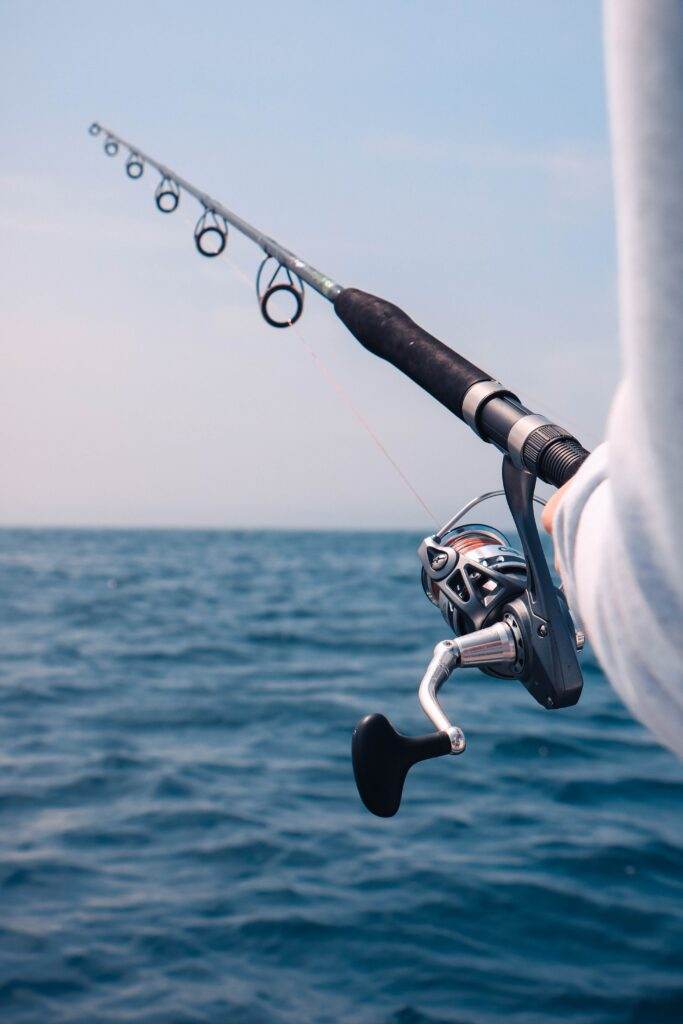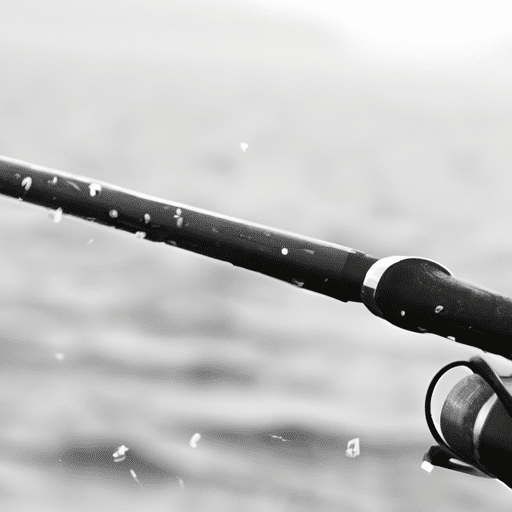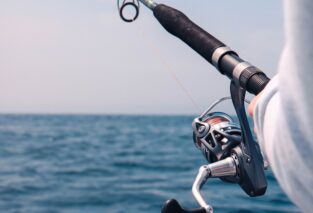Imagine this scenario: you wake up early on a Saturday morning, excited to spend the day fishing. You look out the window only to see gray clouds and rainfall. But wait, can you still go fishing in rainy weather? The answer is a resounding yes! In this article, we will share with you some valuable tips and techniques for fishing in the rain. Whether you are an experienced angler or new to the sport, we’ve got you covered. Don’t let the rain dampen your spirits or ruin your fishing plans. With our advice, you’ll be reeling in the big catches, rain or shine.

Choosing the Right Gear
Waterproof clothing
When fishing in the rain, it is essential to invest in waterproof clothing to keep yourself dry and comfortable. Look for jackets and pants made from materials such as Gore-Tex or nylon with a waterproof coating. These fabrics will repel water and protect you from getting soaked during your fishing adventure. Additionally, consider waterproof hats and gloves to complete your outfit and ensure no part of you is left exposed to the rain.
Waterproof accessories
Apart from clothing, there are several other accessories that you should consider making waterproof to enhance your fishing experience in the rain. Make sure to invest in a waterproof fishing hat or cap to keep your head dry. It’s also a good idea to use waterproof bags or cases for storing your phone, wallet, and any other valuable items. These accessories will not only keep your belongings safe but will also allow you to focus on your fishing without worrying about them getting wet.
Fishing equipment suitable for rain
Fishing equipment can be affected by rain, so it is important to choose gear that is suitable for wet conditions. Look for fishing rods and reels that have corrosion-resistant components to prevent rusting and deterioration. Additionally, opt for lines that are specifically designed for wet environments, as they are less likely to weaken or become brittle when exposed to water. Investing in waterproof tackle boxes is also a smart move to ensure that your lures, hooks, and other accessories remain dry and in good condition.
Protective gear for electronics
If you plan on bringing electronics such as your smartphone or camera on your fishing trip, it’s important to protect them from the rain. Consider purchasing a waterproof phone case or bag to keep your device dry and functional. Similarly, invest in a waterproof camera bag or cover to ensure that your camera is protected from water damage. Taking these precautionary measures will allow you to capture memorable moments without the worry of ruining your electronics in the rain.
Finding the Right Location
Consider changes in water temperature
When fishing in the rain, it’s important to consider the changes in water temperature. Rainfall can cool down the surface temperature of the water, leading to changes in fish behavior. Some species, like trout, tend to become more active and feed more aggressively in cooler water. Take advantage of this by targeting areas where the rainwater is flowing into the main body of water, as these areas will likely have cooler temperatures and an increased likelihood of fish activity.
Select areas with cover
During rainy weather, fish seek shelter and cover to protect themselves from the elements. Look for areas such as overhanging trees, fallen logs, or underwater structures that can provide cover for fish. These areas are likely to attract fish seeking refuge and can be productive fishing spots during rainy conditions. By focusing on areas with cover, you increase your chances of finding active fish and having a successful fishing trip.
Look for runoff points
Rainwater runoff can carry nutrients and food into the water, attracting fish to certain areas. Keep an eye out for runoff points, such as streams or small tributaries entering the main body of water. These runoff points act as natural feeding zones for fish, making them ideal locations to target when fishing in the rain. By fishing near these areas, you increase your chances of encountering hungry fish actively feeding on the influx of food.
Focus on structure and depth
During rainy weather, fish tend to seek out structure and depth for both protection and feeding opportunities. Target areas with submerged structures like submerged rocks, fallen trees, or undercut banks. These structures provide hiding places for fish and create natural ambush points. Additionally, pay attention to changes in depth, as fish may move to deeper areas of the water column during rainfall. By focusing on structure and depth, you increase your chances of locating fish even in adverse weather conditions.

Adjusting Your Techniques
Choose lures with high visibility
When fishing in rainy conditions, it’s essential to choose lures with high visibility. Rainwater can create murky or turbid water, making it more challenging for fish to spot your bait. Opt for bright-colored lures or those with reflective properties that can stand out in cloudy water. These lures will attract the attention of fish and increase your chances of getting a bite, even in less-than-ideal visibility conditions.
Slow down your retrieval
Fish can become sluggish during rainy weather, so adjusting your retrieval speed is crucial. Slow down your retrieval to give fish more time to notice and strike your bait. This technique mimics the natural movements of injured or easy prey, making your lure more enticing to fish. By slowing down your retrieval, you increase the likelihood of triggering a strike and landing a fish, even when they are less active in the rain.
Explore topwater options
Rainy weather often leads to increased surface activity among fish, making topwater lures a valuable option. Topwater lures create commotion and splashes on the water’s surface, mimicking the movements of insects or struggling prey. This technique can be particularly effective for enticing fish that are actively feeding near the surface during or after rainfall. Be patient and vary your retrieval speed to maximize your chances of attracting fish to your topwater lures.
Consider scent-based attractants
In the rain, fish rely less on their sight and more on their sense of smell to locate prey. Enhance your bait’s appeal by incorporating scent-based attractants that appeal to the fish’s olfactory senses. Adding scent-based attractants to your bait, such as fish oils or commercially available scents, can make your bait more irresistible to fish. By utilizing scent-based attractants, you increase the likelihood of attracting fish and enticing them to bite, even in conditions with reduced visibility.
Dealing with Wet Line
Avoid line twist
Wet line can be prone to twisting, which can lead to complications and reduced casting distance. To avoid line twist, ensure that your line spool is properly aligned with your reel before you start fishing. Additionally, consider using a swivel or a snap swivel to minimize line twist when using lures that cause the line to rotate. Taking these precautions will help maintain the integrity of your fishing line and prevent unnecessary frustration while fishing in the rain.
Regularly clean and lubricate your reel
Fishing in wet conditions can lead to increased moisture and potential corrosion on your reel. To keep your reel in good working condition, regularly clean and lubricate it, especially after fishing in the rain. Remove any dirt or debris from the reel and apply a thin layer of reel oil or lubricant to the moving parts. This maintenance routine will extend the lifespan of your reel and ensure smooth operation in future fishing trips.
Dry your line properly after fishing
After a rainy fishing session, it’s important to dry your line properly to prevent it from becoming weak or damaged. Start by wiping off any excess moisture using a clean cloth or towel. Then, stretch out your line and let it air dry in a shaded area. Avoid direct sunlight, as prolonged exposure to UV rays can degrade the quality of your fishing line. By properly drying your line, you maintain its strength and durability, ensuring a better fishing experience in the long run.
Use a line conditioner
To further protect and maintain your fishing line, consider using a line conditioner. Line conditioners are specially formulated sprays or liquids designed to reduce friction and increase the longevity of the line. When applied to your fishing line, they help prevent water absorption, reduce line memory, and improve casting distance. Using a line conditioner regularly will help keep your line in optimal condition, even when fishing in wet conditions.

Safety Precautions
Be cautious of lightning
Fishing in the rain often means being outdoors during potentially stormy conditions, which can increase the risk of lightning strikes. It is crucial to be aware of the weather forecast and have a plan in place to seek shelter if thunderstorms are expected. If you see lightning or hear thunder, it’s time to end your fishing trip and move to a safe location. Avoid staying near bodies of water, tall trees, or metal objects, as they can attract lightning. Your safety should always be the top priority when fishing in rainy weather.
Wear non-slip footwear
Walking on wet surfaces can be slippery and increase the risk of falls or accidents. To prevent slips and maintain stability, it’s recommended to wear non-slip footwear specifically designed for wet conditions. Look for shoes or boots with rubber soles that provide good traction on wet surfaces. By wearing appropriate footwear, you reduce the chances of injuring yourself and enhance your overall safety while fishing in the rain.
Use an appropriate sunblock
Although it may seem counterintuitive, wearing sunblock is important even when fishing in the rain. UV rays can still penetrate through clouds and cause sunburn, especially if you are spending an extended period outdoors. Choose a broad-spectrum sunblock with a high SPF and apply it to exposed skin, including your face, neck, and hands. Protecting your skin from the sun’s harmful rays is essential for long-term skin health, regardless of whether it is a sunny or a rainy day.
Stay aware of changing weather conditions
Weather can be unpredictable, and conditions can change rapidly when fishing in the rain. It’s important to stay alert and keep an eye on any changes in the weather. Pay attention to factors such as wind direction, cloud formations, and sudden drops in temperature, as these can be indicators of approaching storms or dangerous weather conditions. Stay informed by regularly checking weather forecasts before and during your fishing trip. By staying aware of changing weather conditions, you can make informed decisions to ensure your safety while enjoying your time on the water.
Strategies for Fly Fishing in the Rain
Use larger and darker flies
When fly fishing in the rain, it can be beneficial to switch to larger and darker flies. Rainfall tends to darken the water, making it more difficult for fish to see smaller and lighter-colored flies. By using larger and darker flies, you increase their visibility and make them stand out against the darker background. This increases your chances of attracting the attention of fish and enticing them to strike.
Focus on aquatic insect imitations
During rainy weather, aquatic insect activity often increases, as the rain can trigger hatches and create an abundance of insects on the water’s surface. Pay attention to the types of insects present and mimic their behavior by using imitative fly patterns. Use nymphs, emergers, or wet flies that resemble the insects that fish are likely to be feeding on. By focusing on imitating aquatic insects, you can tap into the fish’s natural feeding patterns and increase your chances of success.
Employ nymphing techniques
Using nymphing techniques can be highly effective when fly fishing in the rain. Nymphs are aquatic insects in their immature stages, and fish often feed on them throughout the year. Since nymphs are typically found beneath the water’s surface, they are less affected by rainfall and can still be readily available to fish even in adverse weather conditions. By utilizing nymphing techniques, such as drift fishing or indicator nymphing, you can present your flies at the appropriate depth and increase your chances of enticing fish to bite.
Watch for rising fish
Despite the rain, fish may still rise to the surface to feed on insects that become active due to the precipitation. Keep an eye out for any surface activity, such as fish breaking the water’s surface or ripples indicating feeding fish. This can be a good indicator of where fish are congregating and actively feeding. Adjust your fly selection accordingly and target those areas with precise casts to increase your chances of getting a strike. By observing rising fish, you can adapt your strategy and maximize your success when fly fishing in the rain.

Tips for Bait Fishing in the Rain
Utilize scent-enhanced bait
When bait fishing in the rain, it is beneficial to use scent-enhanced bait to attract fish in conditions with reduced visibility. Adding scents such as fish oils or commercially available attractants to your bait can help create a trail of scent that fish can detect. This increases the likelihood of fish locating your bait and biting. By incorporating scent-enhanced bait, you can overcome the challenges of fishing in the rain and increase your chances of success.
Experiment with different bait types
Rainy weather can affect fish behavior and their preferences for certain types of bait. When bait fishing in the rain, it’s important to experiment with different bait types to see what works best on that particular day. Try using live bait such as worms, minnows, or shrimp, and also consider using prepared baits or artificial lures specially designed for bait fishing. By being open to trying different bait types, you can adjust to the changing conditions and increase your chances of enticing fish to bite.
Target areas near cover or structure
As mentioned earlier, fish seek out cover and structure to protect themselves during rainy weather. When bait fishing, it’s crucial to cast near areas with cover or structure to increase your chances of attracting fish. Target spots such as fallen trees, rock formations, or weed beds where fish may be seeking shelter. By presenting your bait in these areas, you make it more likely for fish to notice and strike your bait, even in less-than-optimal fishing conditions.
Consider using a bait umbrella
Using a bait umbrella can be a practical and effective solution to keep your bait dry and prevent it from washing away in the rain. A bait umbrella is a small, portable shelter that can be attached to your fishing rod. It keeps your bait protected from the rain and creates a small dry zone around your bait, making it more visible and enticing to fish. By utilizing a bait umbrella, you can make your bait fishing more effective and enjoyable even during rainy weather.
Preparing for Adverse Conditions
Pack essential safety items
When fishing in rainy weather, it’s important to be prepared for adverse conditions. Pack essential safety items such as a waterproof first aid kit, a whistle or signaling device, a waterproof map, and a flashlight. These items will ensure that you are equipped to handle any unexpected situations that may arise during your fishing trip. It’s always better to be prepared than to be caught off guard when facing adverse weather conditions.
Stay updated on weather forecasts
Weather forecasts are a valuable tool for planning your fishing trips and staying informed about potential changes in the weather. Before heading out, check the weather forecast for your fishing location and keep track of any updates throughout the day. This will help you make informed decisions about whether to proceed with your fishing plans or seek shelter if conditions deteriorate. Being aware of the forecasted weather conditions allows you to adjust your plans accordingly and ensure the safety and success of your fishing trip.
Use a waterproof backpack or tackle box
Investing in a waterproof backpack or tackle box is a wise choice when fishing in the rain. These waterproof storage solutions will protect your gear, supplies, and personal belongings from getting wet and damaged. Additionally, they will keep your items organized and easily accessible throughout your fishing trip. By using a waterproof backpack or tackle box, you can focus on enjoying your fishing experience without worrying about your belongings being ruined by the rain.
Carry spare clothing
Rainy weather can leave you feeling damp and cold, so it’s important to carry spare clothing in case you need to change into something dry. Pack an extra set of waterproof clothes, including jackets, pants, socks, and shoes. Additionally, bring along a warm hat and gloves to keep yourself comfortable in potentially chilly temperatures. Changing into dry clothes will not only keep you comfortable but also help prevent hypothermia or other related health issues that may arise from prolonged exposure to wet and cold conditions.

Reading Weather Patterns
Understanding how rain impacts fish behavior
Rain can have a significant impact on fish behavior, affecting their feeding patterns, activity levels, and preferred locations. Understanding how rain impacts fish behavior will enable you to make informed decisions and adapt your fishing techniques accordingly. For example, some fish become more active and aggressive during rainfall, while others may seek shelter and become less active. By familiarizing yourself with these patterns, you can increase your chances of success when fishing in the rain.
Identifying optimal times to fish in the rain
While it is possible to fish throughout the day in the rain, certain times may be more productive than others. Pay attention to weather patterns and be on the lookout for optimal times to fish in the rain. Oftentimes, fish activity increases just before or after a rainfall, as changes in oxygen levels and water temperature can stimulate feeding behavior. Additionally, overcast skies and light rain can create favorable conditions for fish to feed closer to the surface. By identifying these optimal times, you can maximize your chances of success when fishing in the rain.
Watching for signs of feeding activity
Observing signs of fish feeding activity is crucial when fishing in the rain. Keep an eye out for surface disturbances, such as fish splashing or jumping, as this often indicates feeding fish. Also, look for ripples or disturbances on the water’s surface, which can indicate fish actively chasing prey. By paying attention to these signs, you can target areas where fish are actively feeding and increase your chances of getting a bite.
Recognizing potential dangers
Rainy weather can bring about potential dangers that need to be recognized and addressed for your safety. Heavy rainfall can cause flash floods or rapidly rising water levels in rivers and streams, making wading dangerous or impossible. Pay attention to water conditions and be cautious if you notice sudden increases in water flow or rising water levels. Additionally, be aware of changes in wind direction and strength, as they can create rough water conditions on lakes or large bodies of water. By recognizing potential dangers, you can make informed decisions and prioritize your safety while fishing in the rain.
Additional Tips and Ideas
Practice casting in wet conditions
Fishing in the rain can affect your casting technique and accuracy. To improve your performance, take the opportunity to practice casting in wet conditions. Adjust your grip and technique to ensure a secure hold on your rod, as wet hands can make it more challenging to maintain a firm grip. Experiment with different casting angles and styles to adapt to the wet environment. By dedicating some time to practice, you can enhance your casting skills and make accurate presentations even in rainy weather.
Stay patient and persistent
Fishing in the rain can present challenges and test your patience. Fish may be less active or selective about their food choices, making it harder to get a bite. However, it’s important to stay patient and persistent. Keep exploring different areas, adjusting your techniques, and trying various baits until you find what works. Remember that fishing is about the adventure and the experience, and staying positive will increase your chances of success even when fishing in less-than-ideal conditions.
Observe the water for any changes
While fishing in the rain, keep a close eye on the water and observe any changes that occur. Rainfall can create subtle or significant changes in water conditions, such as changes in color, flow rate, or temperature. Pay attention to these changes and adjust your fishing strategy accordingly. For example, if heavy rain has turned the water murky, switch to lures with high visibility or rely on scent-based attractants. By observing the water and adapting to its changing conditions, you can increase your chances of finding and enticing fish.
Learn from other anglers
Fishing is a communal activity, and you can learn a great deal from fellow anglers, especially when it comes to fishing in the rain. Engage in conversation with other fishermen at your fishing location, and ask for tips or insights into successful strategies for fishing in rainy weather. Share your experiences and observations with others and be open to receiving advice or suggestions. Learning from other anglers can provide you with valuable knowledge and techniques that you can apply to improve your own fishing skills in the rain.
By following these tips and techniques, you can have an enjoyable and successful fishing experience even in rainy weather. Remember to prioritize safety, adapt to changing conditions, and stay positive throughout your fishing adventure. Rainy weather may present challenges, but with the right gear, techniques, and mindset, you can make the most of your time on the water and create memorable fishing memories.





